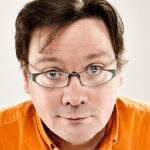From the noosphere to the semantic
At the beginning of the twentieth century, French researcher and philosopher Pierre Teilhard de Chardin (1881-1955) developed the concept of noosphere, which was invented by Vladimir Vernadsk. Wikipedia describes the noosphere as the representation of a thin layer around the earth that would materialise all the consciences of humanity and the capacity of humans to think.
Teilhard de Chardin talks of the advent of a unified and global planet where ideas circulate freely amongst a humanity that has become self-conscious. For the author, this emergence of a planetised intelligence (as he calls it) would not be the result of a spiritual or mystical elevation but the result of rationality: the fusion of intellectual activities would lead to efficiency gains profiting the highest possible number.
In the same era, Belgian scientist Paul Otlet (1868-1944) imagined the Mundaneum, a sort of paper Internet that gathers in one and the same place all knowledge in all its different forms (books, posters, prints, … from all over the world), as Wikipedia states. The enormity of the task was too much for Paul Otlet who had to give up on his project. If you’re interested, you can always visit the documentation centre in Mons.Science fiction writer Philip K. Dick took over the idea of noosphere and took it one step further. According to Dick, we are in contact with the noosphere during our sleep. When you wake up in the morning with an outstanding idea, this is nothing other than the emanation of this symbolic noosphere that reveals itself to us in our dreams.
Later still, Ted Nelson, one of the founding fathers of the Internet, made the noosphere even more concrete with his invention of hypertext links. This has revolutionised the way in which we access knowledge. But Ted Nelson wanted to take things even further. This computer scientist and artist still works at Xanadu, an enormous project that aims to create an unlimited, free-access virtual library.
Whether we are talking about Chardin, Otlet, Dick or Nelson, one question remains when faced with this aggregation of millions of pieces of information: how can we give it a logical organisation that goes beyond a simple pile-up of data? Today, this quest for meaning is at the centre of attention of internet giants such as Google. If they can index the web and make a first hierarchy, the search engines will be able to really interpret the information they inventorise by skimming the web. This challenge nowadays mobilises all the energy. The RDFa could have the solution. This standard was created by Mark Birbeck in 2004 and was adopted by the W3C. Its ambition: to add value to the information that can be found on the web (this is the Web 3.0 that can regularly be heard nowadays).
Instead of building the Internet from scratch, the RDFa proposes to exploit the existing structure and to add information in the HTML as we use it today. Here’s a simple and pragmatic idea, one that could be the kick-off of the semantisation of the web. It could indeed overturn the way we use new technologies.
Internet giants such as Google or Yahoo! have already adopted the RDFa, whereas the Drupal content management system considers integrating it into its platform.
The noosphere is the ancestor of the Web 3.0 or semantic web. Now, it could become a reality, thanks to RDFa. The devil is in the details, they say… And so is innovation, it would seem…
Brice Le Blevennec
Voir nos derniers articles de blog
Voir tous les articles de blog-
Recommandation – comment construire des boucles de recommandation et transformer vos meilleurs clients en ambassadeurs de marque

-
Revenus : Comprendre la valeur à vie de vos clients

-
Fidélisation – comment construire un modèle de fidélisation efficace et réduire le taux d’attrition

-
3 étapes pour faire passer vos utilisateurs de l’engouement à l’activation


